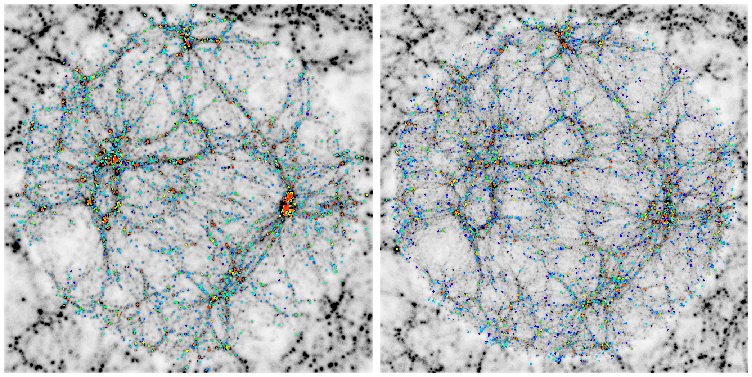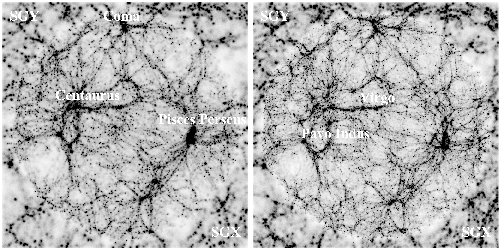
| Constrained Simulations of the Local Galaxy Population |

H. Mathis (1), G. Lemson (2), V. Springel (1), G. Kauffmann (1),
S. D. M. White (1), A. Eldar (2)
and A.Dekel (2)
(1) MPA Garching, (2) Hebrew University
introduction/ collisionless runs/ simulation parameters/ references/ HIGH RESOLUTION PICTURES for astro-ph/0111099 and astro-ph/0201193/ DATA-DOWNLOAD/ slices through the simulation/ movies/ smoothed fields/ Mark III and mock Mark III catalogues/ voids/ links/
We define H0=100 h km/s/Mpc. The
other parameters follow standard notation.
The subscripts "hr" and "lr" refer to the high and low resolution
regions, respectively.
N is the number of (DM) particles, M the mass (units
Msun/h) of one particle, and lsoft is the
physical softening length (units kpc/h).
fbar is the baryon fraction: fbar=Omegabar/Omega0
alpha=star formation efficiency, epsilon=SNe feedback efficiency
fbulge is the
ratio of the satellite galaxy total mass to the central galaxy total mass beyond
which a merger is supposed to trigger a starburst and form a bulge
component
"Feedback" gives the hypothesis that we made for the fate
of the cold gas which has been reheated by the SNe (either ejected from the DM halo and
later reincorporated or always retained in the halo)
MB,lum is the luminosity resolution limit of the simulations
(in the B band), defined as the mean B band magnitude of the central
galaxy of a 10 particle halo at z=0.
MB,morpho the
morphology resolution limit, defined as the mean B band magnitude of the central
galaxy of a 100 particle halo at z=0.
Milky Way look-alikes are defined as galaxies of type Sb/Sc with a
disk circular velocity betwen 200 and 240 km/s.
In the table below, masses are given in units of Msun, disk star
formation rates in units of Msun/year, and we give our zero-point
normalization of the Tully-Fisher realtion.
Detailed pictures of various sizes for the dark matter
distribution, made by Volker Springel, are available here.
The following images
show further projections of slices encompassing the supergalactic
plane, and cut through our LCDM and TCDM cosmologies. A different
colour scale than previously has been used.
To get a more qualitative visual impression, we have smoothed the
galaxy distribution with a gaussian filter, and then projected the
resulting density field on the sky, in
FK4
coordinates and on the supergalactic plane, in
SG
coordinates (caution: both pages host large pictures: download
may be slow).
INTRODUCTION
Our Constrained Realizations (CR) of the Local Universe
simulate the formation and evolution of the neihgbouring
galaxy population starting from initial conditions with a smoothed
linear density field which matches that derived from the IRAS 1.2 Jy
galaxy survey. The simulations track the formation and evolution of
all dark matter haloes more massive than 1011 solar masses out to a
distance of 8000 km/s from the Milky Way. We have implemented prescriptions
similar to those of Kauffmann et al. (1999) to follow the assembly and
evolution of the galaxies within these haloes. We have focused on two
variants of the CDM cosmology: a LCDM and a TCDM model. Galaxy
formation in each was adjusted to reproduce the I-band Tully-Fisher
relation of Giovanelli et al. (1997).
We successfully compared the present-day luminosity functions, colours, morphology and spatial
distribution of our simulated galaxies with those of the real local
population, in particular with the Updated Zwicky Catalogue, the IRAS
PSCz redshift survey, and with individual local clusters such as
Coma, Virgo and Perseus. Although some discrepancies remain, our
simulations recover the observed intrinsic properties and the observed
spatial distribution of the local galaxies reasonably well.
These simulations can thus be used to calibrate methods which use the observed galaxy
population to estimate the cosmic density parameter or to draw
conclusions about the mechanisms of galaxy formation. To facilitate
such work, we publically release
our z=0 galaxy catalogues, together with the underlying mass distribution.
COLLISIONLESS RUNS

The simulations have been carried out on the CRAY T3E at the Computer
Center (RZG) of the Max-Planck Society in Garching.
They used the parallel tree-code
GADGET (Springel et al. 2001). Initially, both
LCDM and TCDM simulated regions have approximatively spherical shapes and comoving
radii of roughly 210 Mpc/h. They then evolve with free boundary
conditions in an expanding universe. The 210 Mpc/h comoving radius
includes an innermost high-resolution (hr) region, extending to
8000 km/s in radius, where the DM particles are the slightest, and an outermost
low-resolution (lr) region, where the DM particles are more massive.
Note that the galaxy formation is followed exclusively in the
high-resolution region, and that we discard all high-resolution DM
haloes contaminated by low-mass particles.
SIMULATION PARAMETERS
Model Omega0 Lambda
h Gamma Sigma8 LCDM 0.3 0.7
0.7 0.21 0.9 TCDM 1.0 0.0
0.5 0.21 0.6
Model
Nhr
Mhr (Msun/h)
lsoft,hr (kpc/h)
Nlr
Mlr (Msun/h)
lsoft,lr (kpc/h)
LCDM
50730389
0.357 x 1010
20
20506522
14.386 x 1010
120
TCDM
53302154
1.18978 x 1010
20
20442823
47.952 x 1010
120
Model
fbar
alpha
epsilon
fbulge
Feedback
MB,lum
MB,morpho
LCDM
0.12
0.05
0.05
0.1
retention
-16.25
-18.46
TCDM
0.2
0.15
0.03
0.1
ejection
-18.45
-20.61
Model
Stellar mass
Cold Gas mass
disk SFR
MB- 5 log h
MI- 5 log h
B-V
Number
LCDM
9.32 x 1010
1.05 x 1010
1.78
-20.02
-22.01
0.74
229
TCDM
1.58 x 1011
1.15 x 1010
3.37
-20.04
-21.99
0.71
941
REFERENCES
Some selected publications :
HIGH RESOLUTION PICTURES
DATA DOWNLOAD
The CR data-download page is available, including
the galaxy and halo void test
populations.
SLICES THROUGH THE SIMULATIONS
SLICES WITH SPECIFIC GALAXY PROPERTIES
More images showing specific properties of the galaxies on top
of the dark matter, for the LCDM model at various redshifts are also
available.
MOVIES
A short
movie shows the galaxy distribution on
spherical shells.
(caution : the movie will play at the rate of the
connexion).
SMOOTHED DENSITY FIELDS
MarkIII and mock Mark III catalogues
Based on the results above, we (eldar@phys.huji.ac.il)
have also constructed mock Mark
III catalogues of peculiar velocities.
Voids
Constrained crealizations of the Local Universe are also ideal to study the simulated
population of galaxies in voids and to evaluate to which extent
semi-analytic models (to their luminosity resolution limit)
successfully reproduce voids as large and as empty as the nearby
ones. We have checked
(astro-ph/0201193)
whether various galaxy and halo populations selected according to
observationally relevant quantities could be considered to be homogeneously
distributed with respect to the bright spirals.
Down to MB=-16.3, we came up wih negative conclusions
for a possible homogeneous population.
Pictures are available
here, and halo and
galaxy catalogues used for the prospection of simulated voids can be downloaded
there.
 Back to the Galaxy Formation Group at MPA
Back to the Galaxy Formation Group at MPA
Last modified: Feb 12, 2002. For Questions / Comments / Remarks : hmathis@mpa-garching.mpg.de